Sociology: Family Trends, Social Inequality, and Life Course Analysis
VerifiedAdded on 2023/06/13
|6
|1140
|202
Essay
AI Summary
This essay delves into various sociological aspects of family dynamics and social inequality. It examines the appropriateness of qualitative approaches in understanding cultural similarities and differences, particularly concerning norms, values, and roles. The life course perspective is highlighted for its utility in identifying family formation principles, emphasizing human development and individual choices. The essay also addresses the negative impacts of hook-up culture, including emotional and psychological injuries, and discusses reasons for declining marriage rates, such as increased awareness of divorce and changing societal preferences. Furthermore, it explores the intersectional perspectives affecting reproductive health and the rise of alternative family formations like same-sex families and cohabitation, alongside a discussion on social inequality, its risk factors for low-income families, and governmental strategies to mitigate poverty in Canada. The document concludes by referencing scholarly articles supporting the arguments presented.
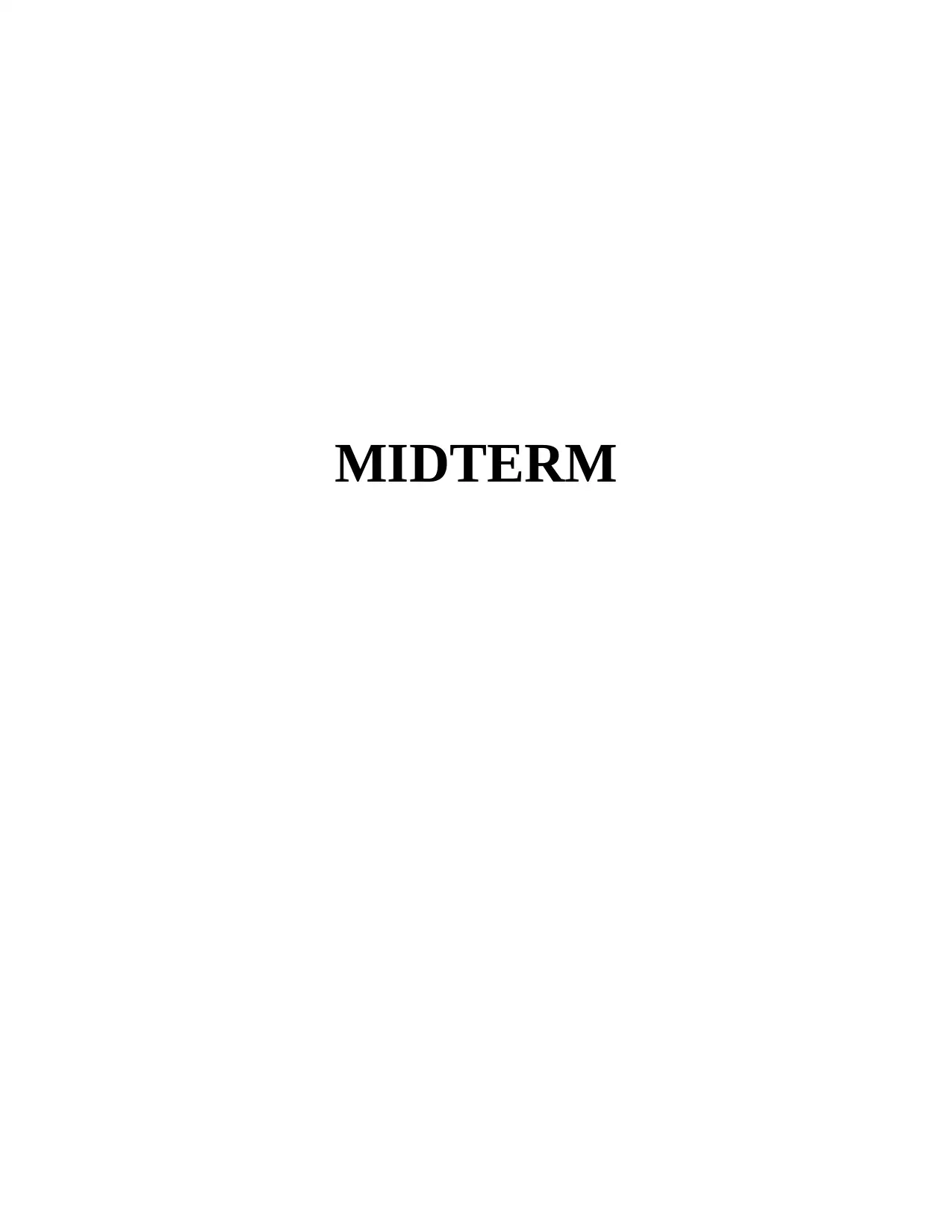
MIDTERM
Paraphrase This Document
Need a fresh take? Get an instant paraphrase of this document with our AI Paraphraser
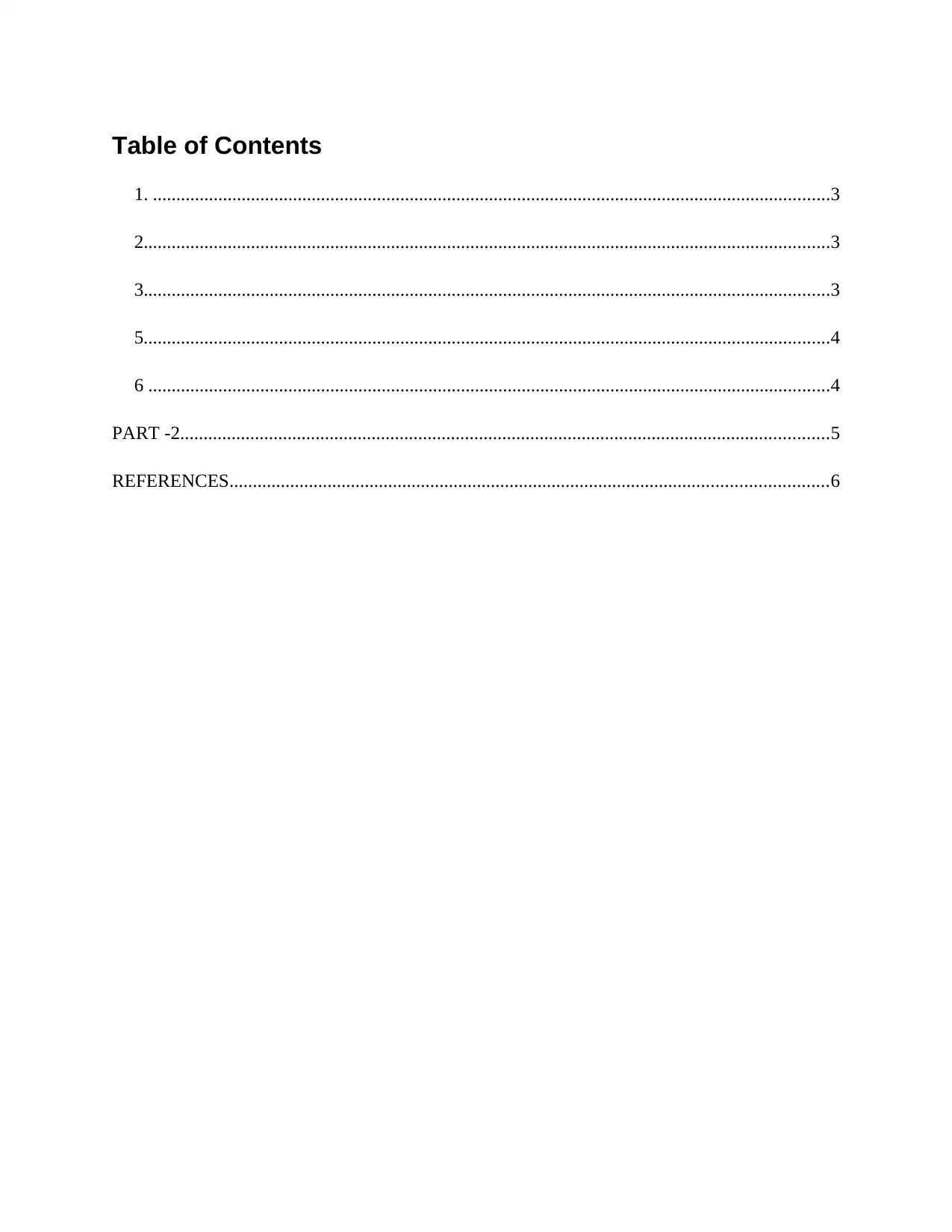
Table of Contents
1. .................................................................................................................................................3
2...................................................................................................................................................3
3...................................................................................................................................................3
5...................................................................................................................................................4
6 ..................................................................................................................................................4
PART -2...........................................................................................................................................5
REFERENCES................................................................................................................................6
1. .................................................................................................................................................3
2...................................................................................................................................................3
3...................................................................................................................................................3
5...................................................................................................................................................4
6 ..................................................................................................................................................4
PART -2...........................................................................................................................................5
REFERENCES................................................................................................................................6
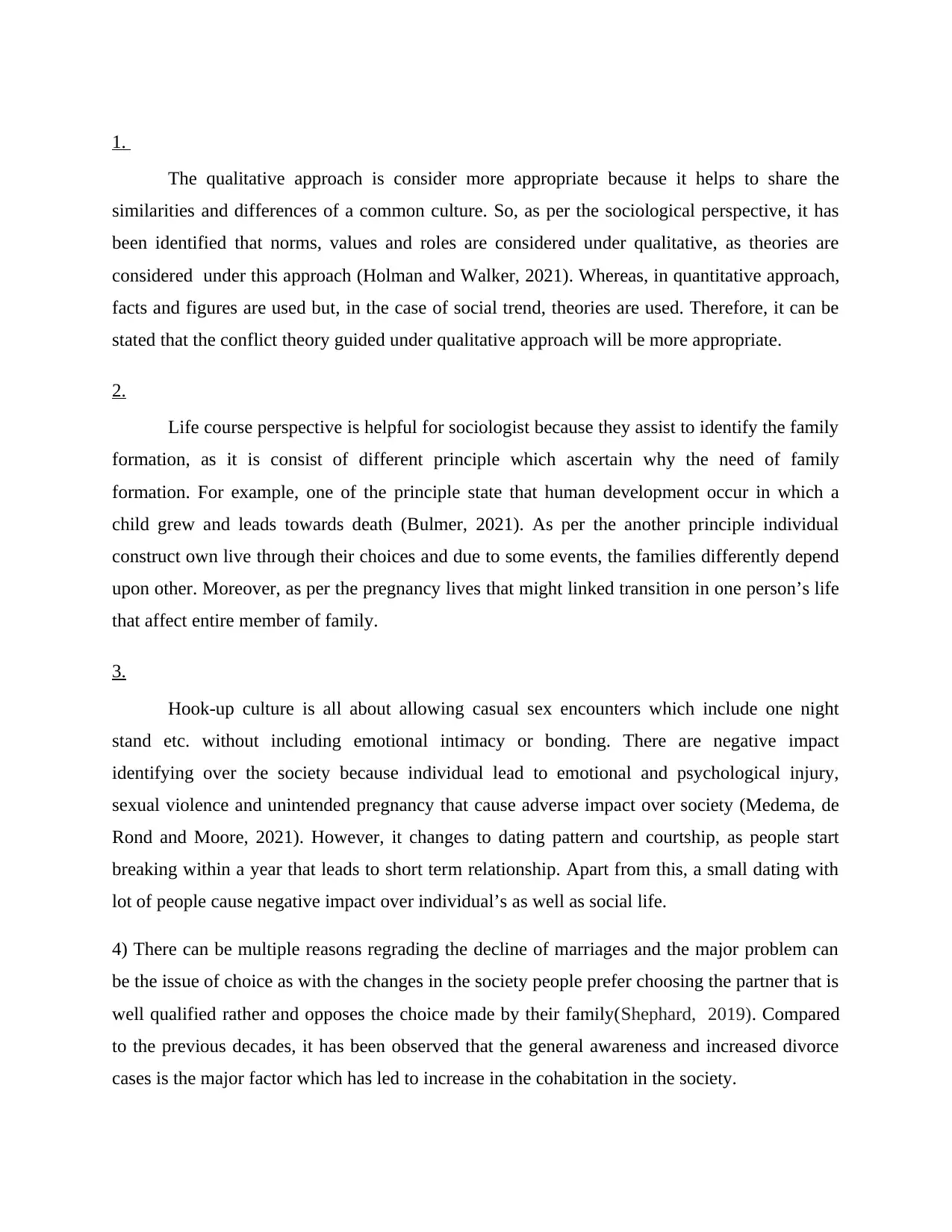
1.
The qualitative approach is consider more appropriate because it helps to share the
similarities and differences of a common culture. So, as per the sociological perspective, it has
been identified that norms, values and roles are considered under qualitative, as theories are
considered under this approach (Holman and Walker, 2021). Whereas, in quantitative approach,
facts and figures are used but, in the case of social trend, theories are used. Therefore, it can be
stated that the conflict theory guided under qualitative approach will be more appropriate.
2.
Life course perspective is helpful for sociologist because they assist to identify the family
formation, as it is consist of different principle which ascertain why the need of family
formation. For example, one of the principle state that human development occur in which a
child grew and leads towards death (Bulmer, 2021). As per the another principle individual
construct own live through their choices and due to some events, the families differently depend
upon other. Moreover, as per the pregnancy lives that might linked transition in one person’s life
that affect entire member of family.
3.
Hook-up culture is all about allowing casual sex encounters which include one night
stand etc. without including emotional intimacy or bonding. There are negative impact
identifying over the society because individual lead to emotional and psychological injury,
sexual violence and unintended pregnancy that cause adverse impact over society (Medema, de
Rond and Moore, 2021). However, it changes to dating pattern and courtship, as people start
breaking within a year that leads to short term relationship. Apart from this, a small dating with
lot of people cause negative impact over individual’s as well as social life.
4) There can be multiple reasons regrading the decline of marriages and the major problem can
be the issue of choice as with the changes in the society people prefer choosing the partner that is
well qualified rather and opposes the choice made by their family(Shephard, 2019). Compared
to the previous decades, it has been observed that the general awareness and increased divorce
cases is the major factor which has led to increase in the cohabitation in the society.
The qualitative approach is consider more appropriate because it helps to share the
similarities and differences of a common culture. So, as per the sociological perspective, it has
been identified that norms, values and roles are considered under qualitative, as theories are
considered under this approach (Holman and Walker, 2021). Whereas, in quantitative approach,
facts and figures are used but, in the case of social trend, theories are used. Therefore, it can be
stated that the conflict theory guided under qualitative approach will be more appropriate.
2.
Life course perspective is helpful for sociologist because they assist to identify the family
formation, as it is consist of different principle which ascertain why the need of family
formation. For example, one of the principle state that human development occur in which a
child grew and leads towards death (Bulmer, 2021). As per the another principle individual
construct own live through their choices and due to some events, the families differently depend
upon other. Moreover, as per the pregnancy lives that might linked transition in one person’s life
that affect entire member of family.
3.
Hook-up culture is all about allowing casual sex encounters which include one night
stand etc. without including emotional intimacy or bonding. There are negative impact
identifying over the society because individual lead to emotional and psychological injury,
sexual violence and unintended pregnancy that cause adverse impact over society (Medema, de
Rond and Moore, 2021). However, it changes to dating pattern and courtship, as people start
breaking within a year that leads to short term relationship. Apart from this, a small dating with
lot of people cause negative impact over individual’s as well as social life.
4) There can be multiple reasons regrading the decline of marriages and the major problem can
be the issue of choice as with the changes in the society people prefer choosing the partner that is
well qualified rather and opposes the choice made by their family(Shephard, 2019). Compared
to the previous decades, it has been observed that the general awareness and increased divorce
cases is the major factor which has led to increase in the cohabitation in the society.
⊘ This is a preview!⊘
Do you want full access?
Subscribe today to unlock all pages.

Trusted by 1+ million students worldwide
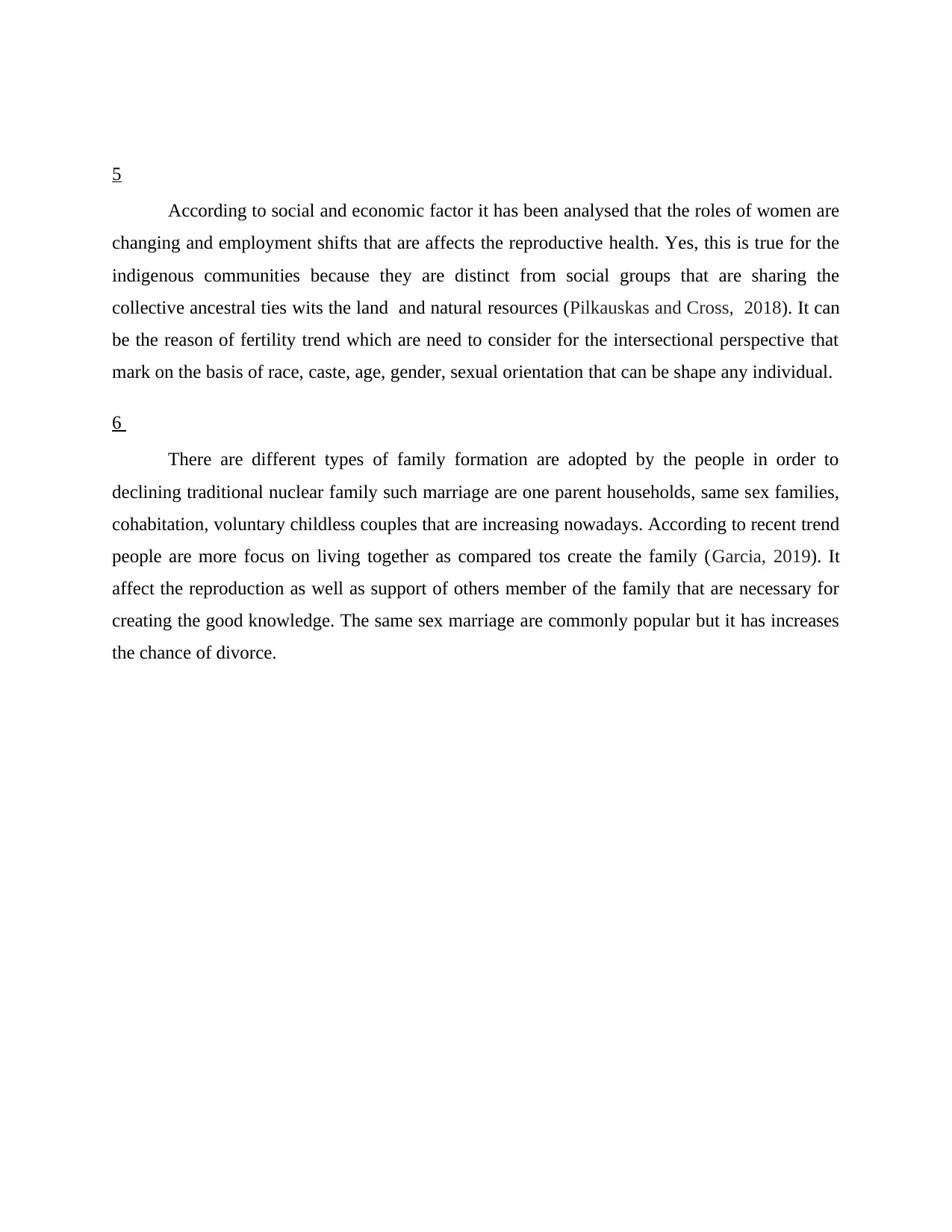
5
According to social and economic factor it has been analysed that the roles of women are
changing and employment shifts that are affects the reproductive health. Yes, this is true for the
indigenous communities because they are distinct from social groups that are sharing the
collective ancestral ties wits the land and natural resources (Pilkauskas and Cross, 2018). It can
be the reason of fertility trend which are need to consider for the intersectional perspective that
mark on the basis of race, caste, age, gender, sexual orientation that can be shape any individual.
6
There are different types of family formation are adopted by the people in order to
declining traditional nuclear family such marriage are one parent households, same sex families,
cohabitation, voluntary childless couples that are increasing nowadays. According to recent trend
people are more focus on living together as compared tos create the family (Garcia, 2019). It
affect the reproduction as well as support of others member of the family that are necessary for
creating the good knowledge. The same sex marriage are commonly popular but it has increases
the chance of divorce.
According to social and economic factor it has been analysed that the roles of women are
changing and employment shifts that are affects the reproductive health. Yes, this is true for the
indigenous communities because they are distinct from social groups that are sharing the
collective ancestral ties wits the land and natural resources (Pilkauskas and Cross, 2018). It can
be the reason of fertility trend which are need to consider for the intersectional perspective that
mark on the basis of race, caste, age, gender, sexual orientation that can be shape any individual.
6
There are different types of family formation are adopted by the people in order to
declining traditional nuclear family such marriage are one parent households, same sex families,
cohabitation, voluntary childless couples that are increasing nowadays. According to recent trend
people are more focus on living together as compared tos create the family (Garcia, 2019). It
affect the reproduction as well as support of others member of the family that are necessary for
creating the good knowledge. The same sex marriage are commonly popular but it has increases
the chance of divorce.
Paraphrase This Document
Need a fresh take? Get an instant paraphrase of this document with our AI Paraphraser
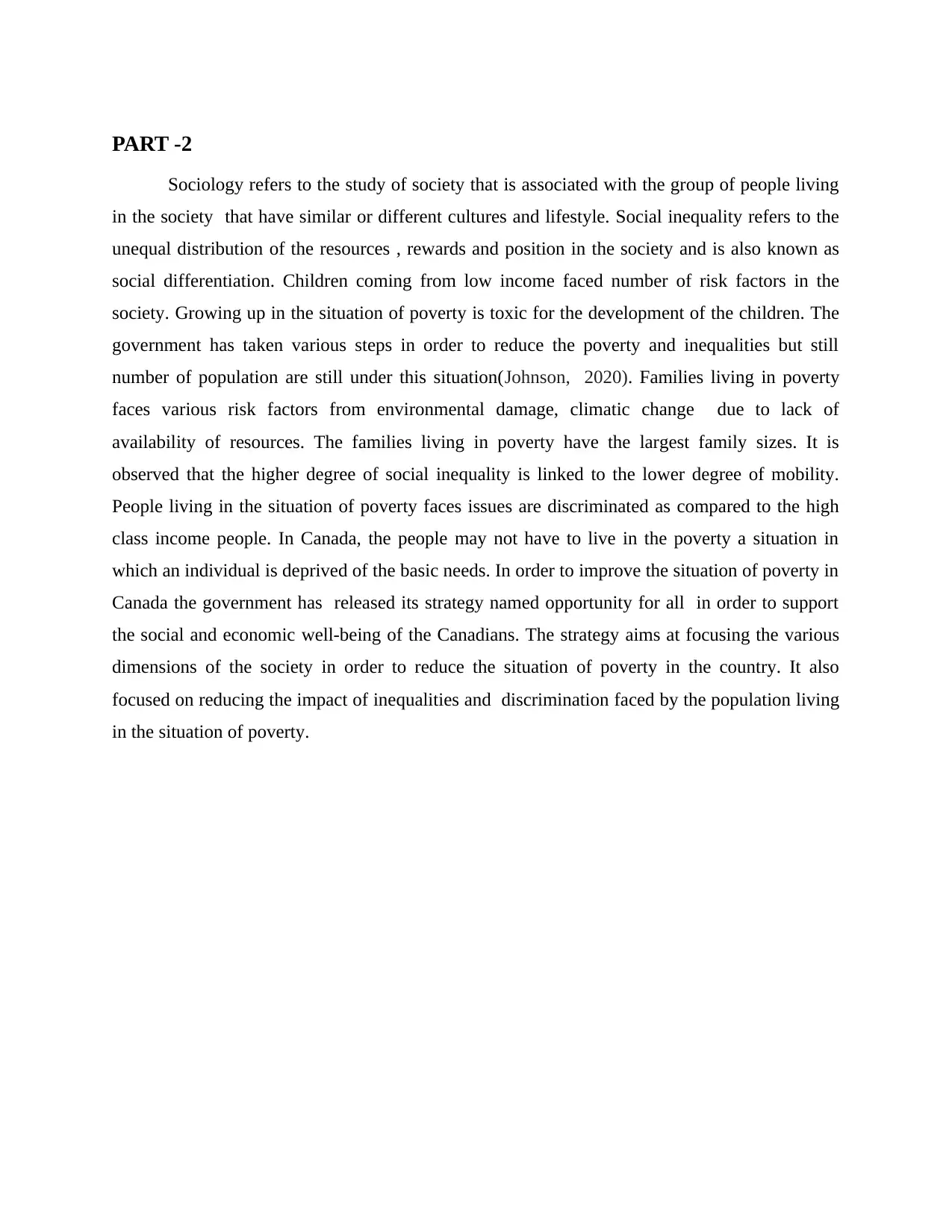
PART -2
Sociology refers to the study of society that is associated with the group of people living
in the society that have similar or different cultures and lifestyle. Social inequality refers to the
unequal distribution of the resources , rewards and position in the society and is also known as
social differentiation. Children coming from low income faced number of risk factors in the
society. Growing up in the situation of poverty is toxic for the development of the children. The
government has taken various steps in order to reduce the poverty and inequalities but still
number of population are still under this situation(Johnson, 2020). Families living in poverty
faces various risk factors from environmental damage, climatic change due to lack of
availability of resources. The families living in poverty have the largest family sizes. It is
observed that the higher degree of social inequality is linked to the lower degree of mobility.
People living in the situation of poverty faces issues are discriminated as compared to the high
class income people. In Canada, the people may not have to live in the poverty a situation in
which an individual is deprived of the basic needs. In order to improve the situation of poverty in
Canada the government has released its strategy named opportunity for all in order to support
the social and economic well-being of the Canadians. The strategy aims at focusing the various
dimensions of the society in order to reduce the situation of poverty in the country. It also
focused on reducing the impact of inequalities and discrimination faced by the population living
in the situation of poverty.
Sociology refers to the study of society that is associated with the group of people living
in the society that have similar or different cultures and lifestyle. Social inequality refers to the
unequal distribution of the resources , rewards and position in the society and is also known as
social differentiation. Children coming from low income faced number of risk factors in the
society. Growing up in the situation of poverty is toxic for the development of the children. The
government has taken various steps in order to reduce the poverty and inequalities but still
number of population are still under this situation(Johnson, 2020). Families living in poverty
faces various risk factors from environmental damage, climatic change due to lack of
availability of resources. The families living in poverty have the largest family sizes. It is
observed that the higher degree of social inequality is linked to the lower degree of mobility.
People living in the situation of poverty faces issues are discriminated as compared to the high
class income people. In Canada, the people may not have to live in the poverty a situation in
which an individual is deprived of the basic needs. In order to improve the situation of poverty in
Canada the government has released its strategy named opportunity for all in order to support
the social and economic well-being of the Canadians. The strategy aims at focusing the various
dimensions of the society in order to reduce the situation of poverty in the country. It also
focused on reducing the impact of inequalities and discrimination faced by the population living
in the situation of poverty.
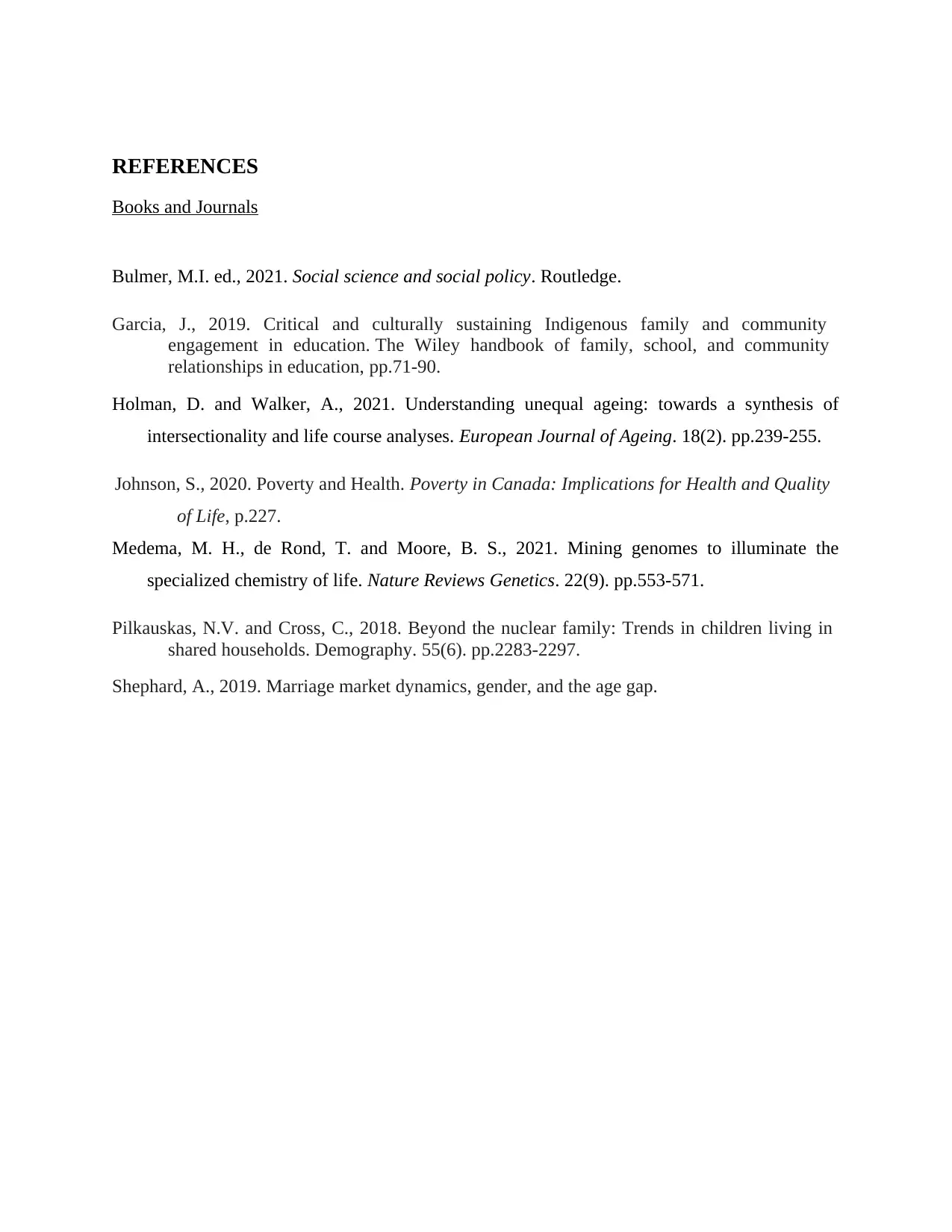
REFERENCES
Books and Journals
Bulmer, M.I. ed., 2021. Social science and social policy. Routledge.
Garcia, J., 2019. Critical and culturally sustaining Indigenous family and community
engagement in education. The Wiley handbook of family, school, and community
relationships in education, pp.71-90.
Holman, D. and Walker, A., 2021. Understanding unequal ageing: towards a synthesis of
intersectionality and life course analyses. European Journal of Ageing. 18(2). pp.239-255.
Johnson, S., 2020. Poverty and Health. Poverty in Canada: Implications for Health and Quality
of Life, p.227.
Medema, M. H., de Rond, T. and Moore, B. S., 2021. Mining genomes to illuminate the
specialized chemistry of life. Nature Reviews Genetics. 22(9). pp.553-571.
Pilkauskas, N.V. and Cross, C., 2018. Beyond the nuclear family: Trends in children living in
shared households. Demography. 55(6). pp.2283-2297.
Shephard, A., 2019. Marriage market dynamics, gender, and the age gap.
Books and Journals
Bulmer, M.I. ed., 2021. Social science and social policy. Routledge.
Garcia, J., 2019. Critical and culturally sustaining Indigenous family and community
engagement in education. The Wiley handbook of family, school, and community
relationships in education, pp.71-90.
Holman, D. and Walker, A., 2021. Understanding unequal ageing: towards a synthesis of
intersectionality and life course analyses. European Journal of Ageing. 18(2). pp.239-255.
Johnson, S., 2020. Poverty and Health. Poverty in Canada: Implications for Health and Quality
of Life, p.227.
Medema, M. H., de Rond, T. and Moore, B. S., 2021. Mining genomes to illuminate the
specialized chemistry of life. Nature Reviews Genetics. 22(9). pp.553-571.
Pilkauskas, N.V. and Cross, C., 2018. Beyond the nuclear family: Trends in children living in
shared households. Demography. 55(6). pp.2283-2297.
Shephard, A., 2019. Marriage market dynamics, gender, and the age gap.
⊘ This is a preview!⊘
Do you want full access?
Subscribe today to unlock all pages.

Trusted by 1+ million students worldwide
1 out of 6
Related Documents
Your All-in-One AI-Powered Toolkit for Academic Success.
+13062052269
info@desklib.com
Available 24*7 on WhatsApp / Email
![[object Object]](/_next/static/media/star-bottom.7253800d.svg)
Unlock your academic potential
Copyright © 2020–2025 A2Z Services. All Rights Reserved. Developed and managed by ZUCOL.





